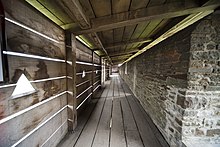Hoarding (castle)

A hoard or hoarding (also known as a brattice or brettice, from the French bretèche) was a temporary wooden shed-like construction that was placed on the exterior of a castle during a siege to allow the defenders to improve their field of fire along the length of a wall and, most particularly, directly downwards to the wall base.[1] The latter function was capably taken up by the invention of machicolations, which were an improvement on hoardings, not least because masonry does not need to be fire-proofed. Machicolations are also permanent and siege-ready.[2]
It is suspected that in peacetime, hoardings were stored as prefabricated elements. Construction of hoardings was often facilitated by putlog holes, sockets that were left in the masonry of castle walls for wooden joists called "putlogs".[3] However, some hoardings were supported on permanent stone corbels.[4]
Some medieval hoardings have survived, including examples at the north tower of Stokesay Castle, England,[5] and the keep of Laval, France. The Château Comtal at Carcassonne and the keep at Rouen Castle, both in France, have reconstructed wooden hoardings,[6] and also Castell Coch in South Wales, which was wholly rebuilt in 1875 and has a hoarding over the drawbridge, designed by the Victorian architect William Burges.[7] Another reconstructed hoarding can be seen at Caerphilly Castle, also in South Wales, which extends along the northern curtain wall of the inner bailey.[1]

See also[]
| Wikimedia Commons has media related to Hoardings (castles). |
- Arrow slit
- Castle
- Drawbridge
- Murder hole
References[]
- ^ a b Hull, Lisa E (2006), Britain's Medieval Castles, Praeger Publishers, ISBN 0-275-98414-1 (p. 67)
- ^ Hogg, Ian V (1975), Fortress: A History of Military Defence, Macdonald and Jane's, ISBN 0-356-08122-2 (p. 21)
- ^ Lepage, Jean-Denis G G (2002), Castles and Fortified Cities of Medieval Europe: An Illustrated History, McFarland & Company Inc, ISBN 978-0-7864-6099-1 (p. 49)
- ^ Thompson, A Hamilton (1912, reprinted 2005), The English Castle: An Account of Its Development as a Military Structure, Dover Publications Inc, ISBN 0-486-44012-5 (p. 81)
- ^ Hourihane, Colum (editor) 2012, The Grove Encyclopedia of Medieval Art and Architecture: Volume 1, Oxford University Press, ISBN 978-0-19-539536-5 (p. 236)
- ^ Thompson, p. 82
- ^ Pettifer, Adrian (2000), Welsh Castles: A Guide by Counties, The Boydell Press, ISBN 0-85115-778-5 (p. 91)
- Castle architecture